Content
- Why kidney inflammation in women should be treated with antibiotics and when it can be avoided
- What groups of antibiotics are used for pyelonephritis
- In acute form
- With chronic course
- List of effective antibiotics
- Amoxicillin
- Amoxiclav
- Azithromycin
- Flemoxin
- Amosin
- Ampicillin
- Ciprofloxacin
- Doxycycline
- Antibiotic prices
- Video about antibiotics for kidney pyelonephritis
Kidney inflammation develops as a result of the penetration of pathogenic bacteria into the organ, therefore, to eliminate the pathology, doctors prescribe antibiotics. When choosing a medicine, it is important to take into account that the pathogen must be sensitive to the main component, and also that, to eliminate pathology in men and women, treatment is carried out in different ways courses.
Why kidney inflammation in women should be treated with antibiotics and when it can be avoided
Inflammation of the kidneys (pyelonephritis) is infectious. And to eliminate the cause of the development of the disease, it is necessary to use a drug that has a destructive effect on the pathogen, and does not eliminate the symptoms of pathology. It is antibiotics that help destroy the infection that causes the appearance of pyelonephritis.
The main goals of antibiotic use for kidney inflammation are:
- destruction of pathogenic bacteria;
- quick elimination of the symptoms of the disease;
- preventing the development of complications of the disease;
- prevention of the re-development of the disease.
If the patient, in the case of personal convictions, refuses to use antibiotics, then the disease can cause the development of the following complications:
- the development of renal failure;
- the formation of purulent inflammation in the kidney tissues;
- the development of blood poisoning;
- blockage of blood vessels in the kidney;
- the formation of kidney stones;
- constantly high blood pressure;
- death of kidney tissue.
The final complication of pyelonephritis, in the absence of therapy, is the failure of the kidney to work, as a result, the organ is removed.
Output. In the presence of inflammation in the kidneys, antibiotics are an obligatory medication in the treatment. Otherwise, the symptoms of the disease will only be suppressed, and the causative agent of the disease will progress.
What groups of antibiotics are used for pyelonephritis
Antibiotics for inflammation of the kidneys in women can only be prescribed by a nephrologist. Self-selection of drugs can harm the body, since when choosing them, it is necessary to take into account the sensitivity of bacteria to the active element, as well as the form of the course of the disease.
In acute form
If a patient is diagnosed with acute pyelonephritis, the doctor must select not one, but several antibiotics from different groups. The selection of drugs from different groups is necessary due to the fact that bacteria gradually get used to the drug, and it becomes ineffective. As a result, a fairly frequent change of drugs is required to completely destroy the pathogen. The course of antibiotic use can be up to 2 months.
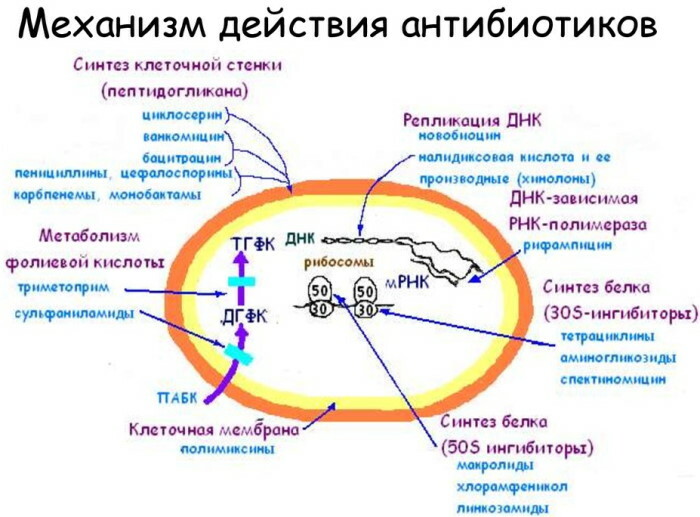
Brief description of antibiotic groups:
| List of groups | Characteristics of antibiotic groups |
| Active component | Amoxicillin trihydrate. |
| 3rd generation cephalosporins | The group occupies one of the leading positions and is often prescribed for the acute form of pyelonephritis. The drugs are highly effective, and the effect of the medication lasts 24 hours. As a result, it is enough to take the drug once a day. |
| Aminoglycosides | Antibiotics are dose-dependent. To increase the effectiveness of treatment, it is recommended to use them in combination with penicillins or cephalosporins. |
| Fluoroquinolones | The drugs are distinguished by a wide spectrum of action and their use is rarely accompanied by the development of side effects. |
| Carbapenems | The group is distinguished by an ultra-wide spectrum of action. |
| Tetracyclines | Medicines are allocated with a wide spectrum of action, but do not destroy Pseudomonas aeruginosa and Proteus. |
| Macrolides | The funds have a wide spectrum of action, and the antibacterial effect can persist up to 24 hours after taking the drug. |
| Penicillins | The drugs have a wide range of action, and also have low toxicity to the body. |
| Azithromycins | Antibiotics have a wide spectrum of action and are excreted from the body with a single dose for about 50 hours, and after completing the course for 1 week. |
In addition to antibiotics, an important component of therapy is the use of immunomodulators and vitamin complexes, since the main medication contributes to a sharp decline in the body's defenses. In addition, antipyretic, anti-inflammatory and analgesic drugs are used, as well as a complex of physiotherapy procedures.
Only combined treatment will completely eliminate the disease and prevent it from becoming chronic.
With chronic course
When diagnosing chronic pyelonephritis, antibiotics are also used in several types and in complex therapy. The difference is longer medication use, which can be lifelong. A woman should not take antibiotics constantly, but in courses, otherwise the immune system can be completely destroyed. The duration of treatment can be from 1.5 to 12 months.
Only correctly selected therapy can achieve long-term remission.
Important. During the period of bearing a child, the woman is prescribed the safest antibiotics to minimize the likelihood of developing pathologies or deformities in the fetus.
List of effective antibiotics
Antibiotics for inflammation of the kidneys in women should be effective, with a wide range of action, and also have a minimum list of side effects. In this group of drugs, doctors include medicines, a list of which with a brief description is presented below.
Amoxicillin
The antibiotic belongs to the group of semi-synthetic penicillins and is produced by pharmaceutical companies in Russia, Serbia and the Netherlands.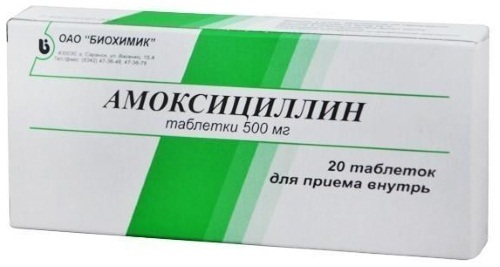
Brief characteristics of the antibiotic:
| Parameters characteristics | Description of parameters |
| Active component | Amoxicillin trihydrate |
| Release form and dosage of the main substance | Tablets with a dosage of the main element of 250, 500 and 1000 mg; capsules with a concentration of 250 and 500 mg; granules for creating a suspension with an amount of the main substance of 250 mg per 5 ml. |
| Antibiotic duration | The main component penetrates into all organs and tissues (including breast milk and the fetus through the placenta) within 1 hour and is excreted from the body within 3 hours. The highest concentration of the drug is observed in the liver tissues. |
| Special instructions for admission | Food intake does not affect the quality and rate of absorption of the main component. But with impaired renal function, as well as in the elderly, the period of drug withdrawal from the body increases. |
| Single and daily dosage and course | Taking one-time requires 500-100 mg of the drug with a frequency of 3 times every 24 hours. The maximum permissible daily dosage should not exceed 6 g. The duration of admission can be from 5 to 12 days. |
| Prohibitions by age, during pregnancy and lactation | Capsules and tablets can be taken from the age of 12, and granules for suspension can be taken from birth. When carrying a child, Amoxicillin is approved for use, but at the individual dosage indicated by the doctor. During lactation, it is necessary to temporarily transfer the baby to breastfeeding. |
| Features in prohibitions and adverse reactions | The drug has classic prohibitions and negative effects typical for antibiotics. |
In complex therapy, Amoxicillin should be used with extreme caution.
Amoxiclav
The antibiotic belongs to the group of broad-spectrum penicillins and is produced by pharmaceutical companies in Slovenia and Austria.
Brief characteristics of the antibiotic:
| Parameters characteristics | Description of parameters |
| Active component | Amoxicillin and clavulanic acid. The second element improves the absorption of the first component and reduces the likelihood of side effects. |
| Release form and dosage of the main substance | Tablets content of active ingredients in an amount:
Powder for suspension for oral administration with a dose of 5 ml of ready-made solution:
Powder for suspension for injection use:
Where the first component is amoxicillin, and the second is clavulanic acid. |
| Antibiotic duration | The antibacterial effect is observed within 60 minutes after using the drug. The withdrawal time of the active substance from the tissues is approximately 3 hours. The active element penetrates into all fluids, tissues and organs, and also enters the fetus and breast milk. |
| Special instructions for admission | The time of eating does not affect the rate and quality of absorption of the antibiotic. |
| Single and daily dosage and course | Prescribe 500 or 1000 mg of amoxicillin (as well as 125 or 250 mg of clavulanic acid). The maximum allowable dose per day for more than 6 g of the first element and 600 mg of the second component. The duration of antibiotic use is selected individually, but after stabilization of the condition, it is required to continue the course of treatment for another 48 hours to consolidate the result. |
| Prohibitions by age, during pregnancy and lactation | Tablets are prescribed from 12 years old, provided that the patient's weight is at least 40 kg. Suspension granules (oral and injection) can be used from birth. During the period of breastfeeding and carrying a child, it is not advisable to use the drug, but if there is a threat to the mother's life, then the antibiotic is used at an individual dosage. |
| Features in prohibitions and adverse reactions | In severe pathologies of the kidneys and liver, the antibiotic can be taken only at an individual dosage. The rest of the prohibitions and side effects are similar to other antibiotics. |
In complex therapy, Amoxiclav should be used with extreme caution.
Azithromycin
The antibiotic Azithromycin belongs to the group of semisynthetic azithromycins with a broad spectrum of action. The medicine is produced by pharmaceutical companies in different countries. The drug is also often prescribed for inflammation of the kidneys and in women.
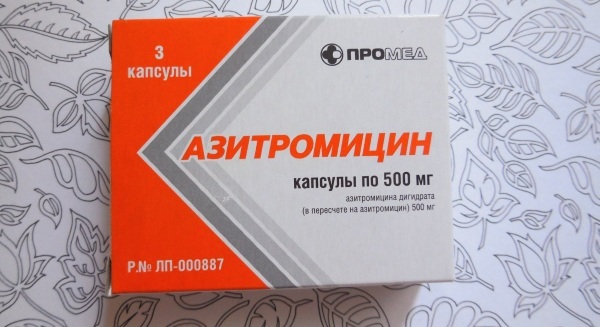
Brief characteristics of the antibiotic:
| Parameters characteristics | Description of parameters |
| Active component | Azithromycin |
| Release form and dosage of the main substance | Tablets and capsules containing 250 or 500 mg of the main component, as well as powder for oral administration with a concentration of 15, 30 and 75 mg of the active ingredient. |
| Antibiotic duration | The antibiotic effect is observed within 3 hours after its administration and can persist up to 7 days. The main element can penetrate into fluids, tissues, as well as to the fetus and breast milk. |
| Special instructions for admission | The antibiotic is used 2 hours before or after eating. |
| Single and daily dosage and course | Take 500 or 1000 mg once every 24 hours. The course is 7-10 days. |
| Prohibitions by age, during pregnancy and lactation | Capsules and tablets are allowed to be used by patients weighing more than 45 kg, and the suspension can be taken from birth. When lactating and carrying a child, it is not advisable to use an antibiotic. |
| Features in prohibitions and adverse reactions | The antibiotic has a significantly smaller list of contraindications and side effects. |
In complex therapy, Azithromycin should be used with extreme caution.
Flemoxin
The antibiotic belongs to the group of broad-spectrum penicillins and is manufactured by a pharmaceutical company in the Netherlands.

Brief characteristics of the antibiotic:
| Parameters characteristics | Description of parameters |
| Active component | Amoxicillin |
| Release form and dosage of the main substance | Tablets containing 125, 250 or 1000 mg of the main component. |
| Antibiotic duration | The effect of the drug is observed within 120 minutes after taking it and lasts up to 3 hours. In case of impaired renal and liver function, the period of drug withdrawal from the body is doubled. |
| Special instructions for admission | Food intake does not affect the rate and quality of antibiotic absorption. |
| Single and daily dosage and course | Assign 250-500 mg, which is required to be taken 3 times every 24 hours. The duration of taking Flemoxin is individual. After the normalization of the condition, it is required to extend the antibiotic intake for another 2 days in order to consolidate the result obtained. |
| Prohibitions by age, during pregnancy and lactation | The tool has no age restrictions, since the tablet form is allowed to be taken by children, having previously dissolved the drug in water. When carrying a child and lactation, Flemoxin is allowed to be used, but at an individual dosage. |
| Features in prohibitions and adverse reactions | None. |
In complex therapy, Flemoxin should be used with extreme caution.
Amosin
Antibiotics for inflammation of the kidneys in women should be selected strictly by a doctor. Amosin belongs to the group of semi-synthetic penicillins with a wide range of action and is produced by a Russian pharmaceutical company.
Brief characteristics of the antibiotic:
| Parameters characteristics | Description of parameters |
| Active component | Amoxicillin |
| Release form and dosage of the main substance | Capsules containing 250 mg of the main element; tablets with a concentration of 250 and 500 mg; suspension with a dosage of 125 and 250 mg of the main component; a solution containing 250 and 500 mg of the main substance. |
| Antibiotic duration | With oral use, the antibiotic effect occurs within 60 minutes and lasts up to 3 hours. And when using injections, the therapeutic effect is noted within 15 minutes and can last up to 8 hours. |
| Special instructions for admission | Food intake does not affect the absorption and action of the antibiotic. |
| Single and daily dosage and course | Take 500-100 mg with a frequency of 3 times every 24 hours. The duration of the course is from 5 to 12 days. After the patient's condition has returned to normal, the antibiotic should be continued for another 48 hours. |
| Prohibitions by age, during pregnancy and lactation | Capsules and tablets are taken after 12 years, and suspension and injections are allowed from birth. During lactation, the drug is not used, and during the period of bearing a child, it is possible to use Amosin with the permission of a doctor and at an individual dosage. |
| Features in prohibitions and adverse reactions | In renal and hepatic insufficiency, an individual dosage is required. |
In complex therapy, Amosin should be used with extreme caution.
Ampicillin
The antibiotic belongs to the group of semi-synthetic penicillins with a wide range of action and is produced by pharmaceutical companies in different countries.
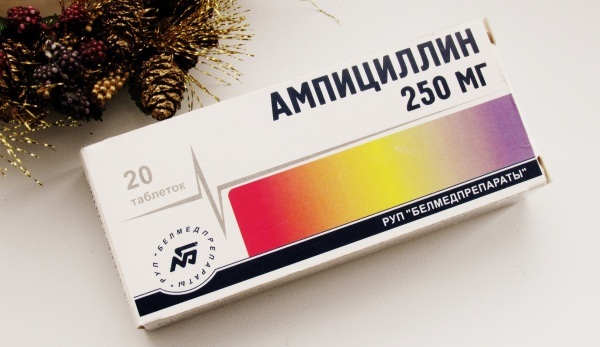
Brief characteristics of the antibiotic:
| Parameters characteristics | Description of parameters |
| Active component | Ampicillin |
| Release form and dosage of the main substance | Tablets and capsules containing 250 mg of active ingredient; suspension with a concentration of 125 and 250 mg and a solution with a dosage of 250, 500, 1000, and 2000 mg. |
| Antibiotic duration | The therapeutic effect occurs within 2 hours and lasts up to about 4 hours. The antibiotic penetrates into all tissues, fluids and organs, including the fetus and breast milk. |
| Special instructions for admission | It is recommended to take an antibiotic 60 minutes before a meal. |
| Single and daily dosage and course | Assign 500-100 mg 2-4 times a day, but not more than 4 g in 24 hours. |
| Prohibitions by age, during pregnancy and lactation | The drug in tablet and capsule form is not used until 12 years old, and other forms of release are allowed from 1 month. |
| Features in prohibitions and adverse reactions | The antibiotic has a smaller list of side effects and inhibitions. |
In complex therapy, Ampicillin should be used with extreme caution.
Ciprofloxacin
Antibiotics for inflammation of the kidneys in women are dispensed with a prescription from a doctor; there are no drugs on the market. Ciprofloxacin belongs to the group of fluoroquinolones with a wide range of action and is produced by pharmaceutical companies in different countries.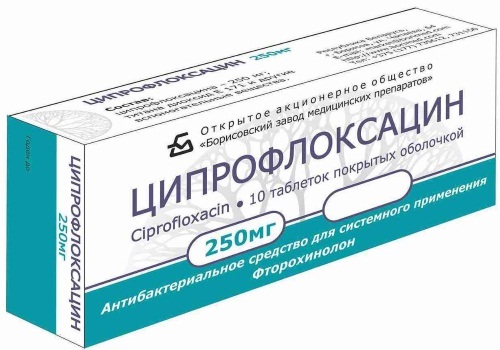
Brief characteristics of the antibiotic:
| Parameters characteristics | Description of parameters |
| Active component | Ciprofloxacin hydrochloride. |
| Release form and dosage of the main substance | Tablets with a dosage of 250, 500 and 750 mg, as well as a solution for injection with a concentration of 2 mg per 1 ml. |
| Antibiotic duration | The therapeutic effect is observed for about 2 hours after taking the drug and lasts for about 24 hours. |
| Special instructions for admission | The antibiotic should be taken regardless of food intake, but the amount of water consumed per day should be increased. |
| Single and daily dosage and course | Take 500-100 mg per day (divide the dose by 2 times). The duration of therapy is set individually. |
| Prohibitions by age, during pregnancy and lactation | The antibiotic is prohibited during breastfeeding, pregnancy, and also under 12 years of age (for these forms of release). |
| Features in prohibitions and adverse reactions | For pathologies of the kidneys and liver, an individual dosage is required. |
In complex therapy, Ciprofloxacin should be used with extreme caution.
Doxycycline
The antibiotic belongs to the group of broad-range tetracyclines and is produced by pharmaceutical companies in Russia and Belarus.
Brief characteristics of the antibiotic:
| Parameters characteristics | Description of parameters |
| Active component | Doxycycline |
| Release form and dosage of the main substance | Capsules containing 100 mg of the main substance, lyophilisate with a dosage of 100 mg per 1 ampoule and tablets with an active element concentration of 100 mg. |
| Antibiotic duration | The effect of the drug is observed for about 2 hours and lasts up to 25 hours. |
| Special instructions for admission | Food intake does not affect the action and absorption of the antibiotic. |
| Single and daily dosage and course | Take 100 mg of the drug 1-3 times within 24 hours. The course is set individually. |
| Prohibitions by age, during pregnancy and lactation | Doxycycline is prohibited during lactation, up to 8 years and during pregnancy (especially 2 trimester). |
| Features in prohibitions and adverse reactions | In severe liver pathologies, the medication is used with an individual dosage. |
In complex therapy, Doxycycline should be used with extreme caution.
Antibiotic prices
The price for the drugs considered in the publication is in the following range:
| Name of the medication | The amount of the drug | Minimum price (in rubles) | Maximum price (in rubles) |
| Amoxicillin | Capsules, 500 mg, 16 pcs. | 100 | 135 |
| Tablets, 250 mg, 10 pcs. | 38 | 52 | |
| Granules, 250 mg, 40 g | 89 | 126 | |
| Amoxiclav | Tablets 500 + 125 mg, 15 pcs. | 376 | 458 |
| Suspension powder 250 + 62.5 mg | 249 | 310 | |
| Azithromycin | Suspension powder 1000 mg, 16.5 g | 156 | 232 |
| Capsules, 500 mg, 2 pcs. | 222 | 306 | |
| Tablets, 500 mg, 3 pcs. | 206 | 287 | |
| Flemoxin | Tablets, 1 g, 20 pcs. | 438 | 523 |
| Tablets, 500 mg, 20 pcs. | 333 | 427 | |
| Amosin | Tablets, 500 mg, 20 pcs. | 126 | 194 |
| Suspension powder 250 mg | 58 | 93 | |
| Ampicillin | Ampoules, 1000 mg, 10 pcs. | 1898 | 1998 |
| Tablets, 250 mg, 10 pcs. | 24 | 42 | |
| Ciprofloxacin | Tablets, 500 mg, 10 pcs. | 42 | 73 |
| Solution for injection, 0.2%, 100 ml. | 3518 | 3724 | |
| Doxycycline | Tablets, 1000 mg, 10 pcs. | 268 | 386 |
Inflammation of the kidneys is a dangerous disease that, if left untreated, can result in serious complications. And since the pathology is infectious in nature, to eliminate it, it is necessary to take antibiotics without fail (for both women and men).
Author: Kotlyachkova Svetlana
Video about antibiotics for kidney pyelonephritis
Antibiotics for kidney pyelonephritis:



